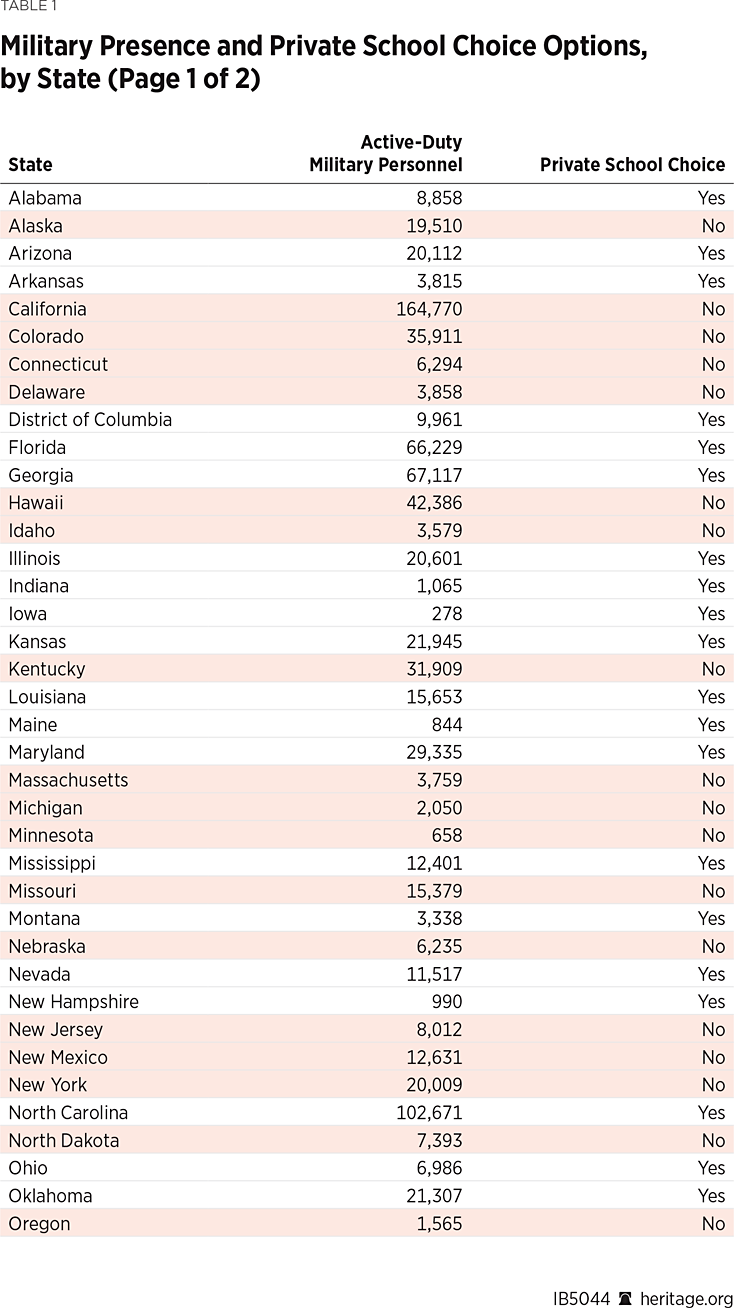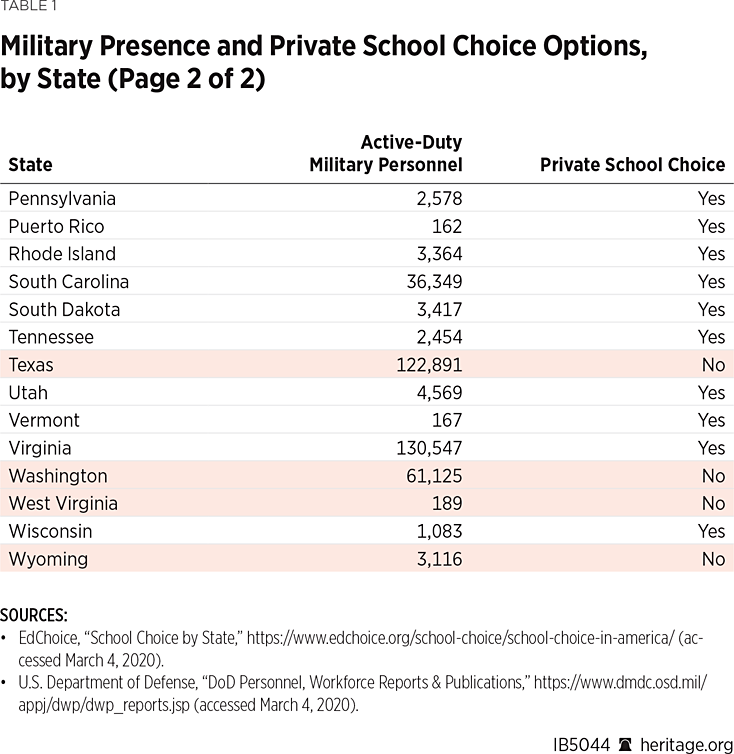Military families make tremendous sacrifices—which too often include having to send their children to schools that are not the right fit for them. Many military families cannot afford private school tuition, and most bases do not host Domestic Dependent Elementary and Secondary Schools (DDESS), high quality schools operated by the Department of Defense. Consequently, most children from military families have to attend the public school that is physically closest to their parents’ assigned base. While school choice policies are popular among military families, the fact that 84 percent of military-connected children attend public schools illustrates the lack of educational options available to military families.REF Outdated federal education policies have failed to accommodate the flexibility and mobility the military requires of service members and their families.
The federal government has a constitutional duty to ensure national security, which uniquely extends to the K–12 education of military-connected children. Accordingly, federal policymakers could improve attrition and retention of service members by offering education savings accounts (ESAs) to active-duty military families. Allowed to control their children’s education, military families would no longer feel pressure to forgo promotions or leave the military altogether to ensure that their children receive a good education. As this Issue Brief explains, to create more education options for military-connected children, Congress should pilot an ESA program for military-connected children at bases that do not host DDESS schools (base schools), enabling them to attend a private school of choice, or to pay for other education-related services, products, and providers.
Domestic Dependent Elementary and Secondary Schools: Successful, But There Are Too Few of Them
Military families nationwide are dissatisfied with the lack of educational opportunities for their children. Frances Tilney Burke explained why her own military family prefers to homeschool or attend parochial schools due to the frequent military moves (her daughters, ages 10 and 11, “are attending their fifth schools”):
All transitions are hard, but moving a child from one private-school or home-schooling community to another is a gentler, more flexible process than subjecting them to the often rigid rules of public schools. Additionally, many of the public school options either on or right outside a military installation are subpar, and private or home-school options may be better.REF
The fact that military families homeschool at twice the rate of the civilian average underscores the lengths to which military families go to have flexible education options.REF Unsurprisingly, a 2015 survey from the Military Times indicated that “35 percent of respondents said that dissatisfaction with their child’s education was a ‘significant factor’ in their decision to remain in or leave military service.”REF These data are even more striking when considering that “the age of most military personnel means many have children school-aged and younger.”REF The lack of K–12 education options for military families becomes a matter of national security since it directly affects the military’s efforts to attract and retain service members.
The Defense Department operates DDESS schools, which regularly perform above the national average for all students. Last year, DDESS fourth graders outperformed their peers nationwide in reading on the National Assessment of Educational Progress (NAEP). Similarly, DDESS eighth graders tied with Massachusetts for the best NAEP scores in math.REF
Currently, 50 DDESS facilities operate on 15 military bases (of approximately 300) in the contiguous United States, serving approximately 21,317 students.REF Although they perform well, these schools serve 4 percent of military-connected children—a fraction of the roughly 528,000 school-aged children whose parents are stationed in the contiguous United States.REF Moreover, DDESS schools operate only in the eastern United States, and only serve students whose families live on base. Consequently, military-connected children whose families are stationed off base or in the western United States cannot attend a DDESS school. Since fewer than 6 percent of military bases in the contiguous United States have DDESS, most military-connected children have to attend whichever public school is closest to their parents’ base assignment, and have few education alternatives besides their assigned public school.
Military Families Want School Choice
Military families overwhelmingly support school choice initiatives. A 2019 EdChoice survey found that 72 percent of military respondents supported ESAs for military-connected children.REF ESAs are parent-controlled and often funded with 90 percent of the education dollars that the traditional district schools spend per student—leaving 10 percent as savings for taxpayers.REF
The ESA model has already been successfully implemented in five states: Arizona, Florida, Mississippi, North Carolina, and Tennessee. In Arizona, parents whose children are eligible for an ESA receive 90 percent of what the state would have spent on their child in the public school system—approximately $6,000 per year in their account. Those funds are deposited directly into their child’s ESA, and funds can then be used to pay for any education-related service, product, or provider, including private school tuition, online learning, special education services and therapies, and private tutoring, among other options.
Unused funds can be rolled over from year to year, and can even be rolled into a college savings account. ESAs would be well-adapted to the military lifestyle, enabling these families who are highly mobile to choose schools that are the right fit for their children when they move from base assignment to base assignment, or to maintain consistency in their education through online learning and private tutoring. Currently, fewer than half of military families live in states that have any type of school choice—a policy gap that urgently needs rectifying.REF (See Table 1.)


Piloting Military ESAs
Congress should pilot an ESA program for military-connected children at bases that do not host DDESS schools.REF Specifically, Congress should pilot a military ESA program on military bases in states where the Defense Department does not already operate schools as part of the re-authorization of the National Defense Authorization Act. Congress should enable families who do not live on one of the 15 bases with DDESS schools to receive an ESA. ESAs would let parents choose education options that are the right fit for their children, wherever their next assignment takes them. Indeed, Arizona’s ESA program provides a tried-and-ready model for federal policymakers.REF ESAs are flexible and accommodate the highly mobile lifestyle required of United States service members and their families. Policymakers should structure the pilot program to allow families on the approximately 285 non-DDESS bases in the United States to access federally funded ESAs.
Only 21,000 of 500,000 school-aged military-connected children are enrolled in DDESS schools in the contiguous United States. The remaining 479,000 children should no longer be forced to attend the nearest civilian public school, whether the school is good and safe or not. Besides private school tuition, military families could also use their ESA to pay for private tutors, online learning, and any other education-related service, product, or provider.
Serving Military Families as Well as They Serve the Nation
Since K–12 education is a significant factor in many military families’ decisions to remain in or leave the military altogether, vastly improving education opportunities is not only smart education policy, but a matter of national security. Establishing ESAs for military-connected children will allow military parents to choose the education option that is best for their children—and is a long-overdue way of supporting the country’s service members and their families.
Jude Schwalbach is Research Assistant in the Center for Education Policy, of the Institute for Family, Community, and Opportunity, at The Heritage Foundation.


